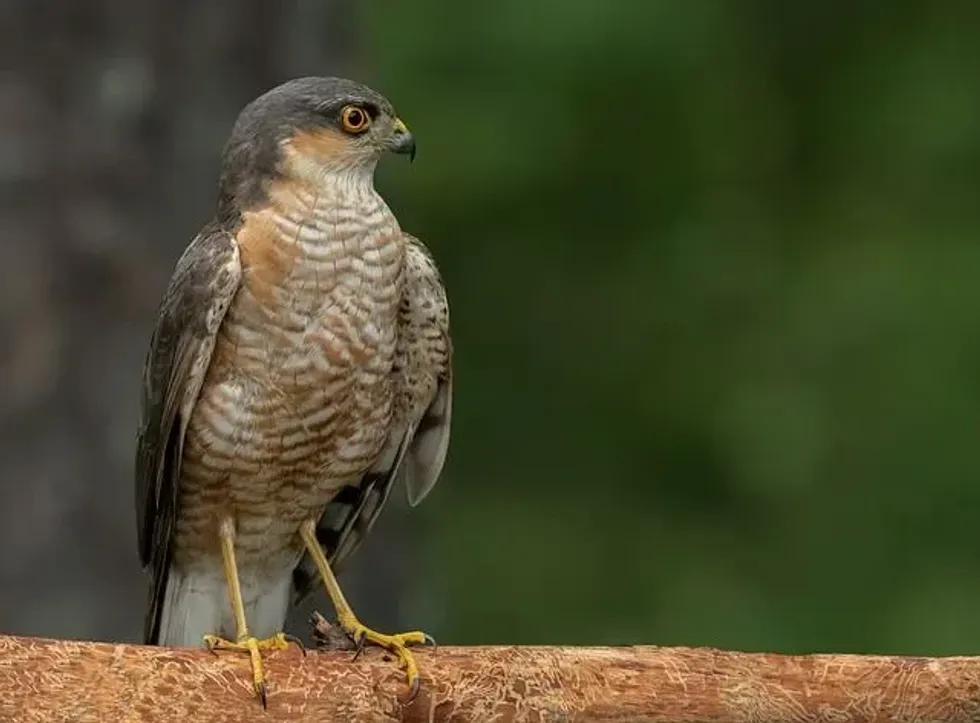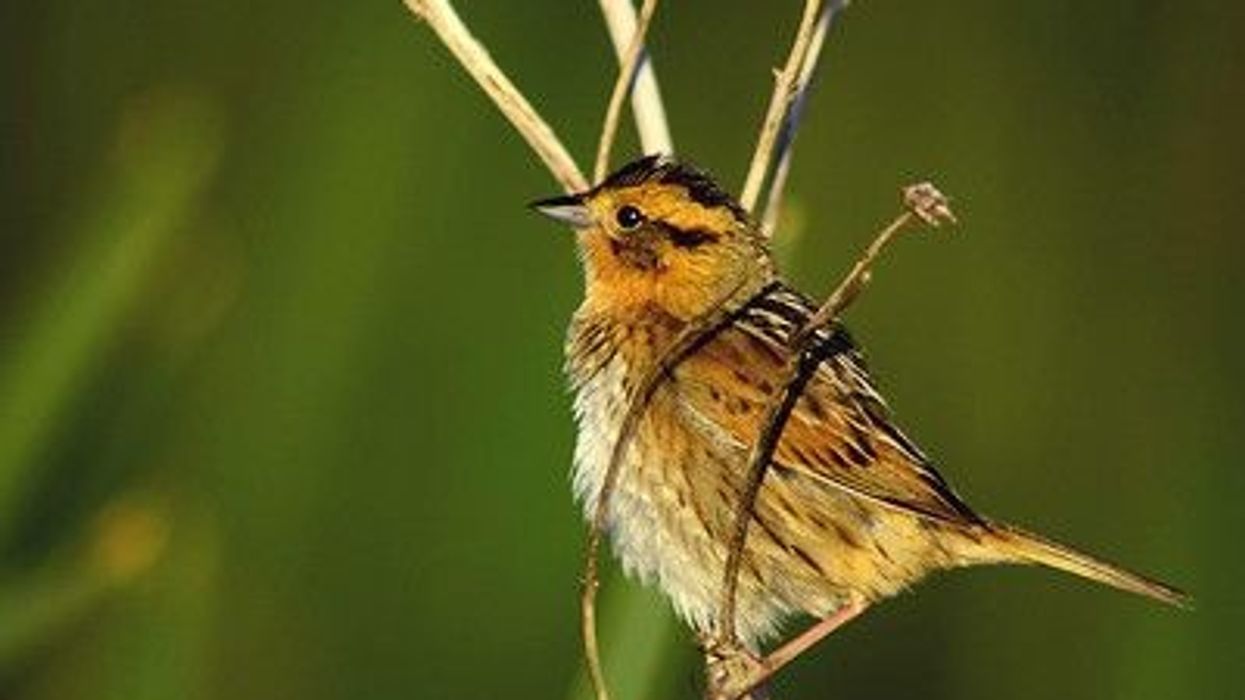The Eurasian sparrowhawk (Accipiter nisus) are small birds that have long tails and yellow legs. The adult male sparrowhawks have slate-gray colored upperparts while the underparts are rufous barring. The females have a brownish-gray appearance on the upper body.
They have round wings and do not soar frequently. Sparrowhawks eat other birds who are sick or injured.
In the summer season, 40 percent of the diet of a sparrowhawk consists of fledglings. When it comes to size, the female sparrowhawk is larger in size when compared to the male sparrowhawk. This species appears quite similar to goshawk wherein a female sparrowhawk is almost the same size as a male goshawk.
They are hunter birds and can catch other birds ranging from the size of a goldcrest to a pheasant. The male sparrowhawk, as well as female sparrowhawk, need to eat more often as they can only survive for around a week without food. More than 120 species of birds have been prey to a sparrowhawk.
After reading about this bird of prey, you may also take a look at peacock facts and coopers hawk facts.
Sparrowhawk Interesting Facts
What type of animal is a sparrowhawk?
A Eurasian sparrowhawk (Accipiter nisus) is a hunter bird that hunts down nestlings, fledglings, and other smaller birds as their diet. They can be found in multiple habitats throughout both rural and urban areas. They build their nests in thick woodland.
What class of animal does a sparrowhawk belong to?
Sparrowhawks, also known as Accipiter nisus, belong to the class of birds. The population of the sparrowhawk depends on the availability of prey.
If abundant prey is available for the sparrowhawk to feed on, its population will increase. They can be found in scrub or broadleaf forests, valleys, edges of streams and rivers. Agricultural fields, open lands are also where this bird species can be found.
How many sparrowhawks are there in the world?
The conservation status of sparrowhawks as listed by the IUCN Red List as of the Least Concern which suggests that the population of sparrowhawks is stable. In fact, the population of sparrowhawks is increasing as they cannot be affected by pesticide contamination, and the illegal killing of these birds has decreased.
The other species of the sparrowhawk, the Eurasian sparrowhawk, had an estimated population of 1.5 million back in 2009.
Where does a sparrowhawk live?
Woods, farms, dense forests, bushlands and thickets are different locations where sparrowhawks live. They can also live in gardens and parks in urban areas.
What is a sparrowhawk's habitat?
Sparrowhawks are not found in gardens or parks when the temperature drops and the weather becomes wet. The habitat of the sparrowhawk tends to change according to the changes in weather conditions. They usually prey on fish and live near the edges of streams and lakes. During summer, they look for fledglings for consumption.
Who do sparrowhawks live with?
Sparrowhawks live in territories and build pairs. The nests of each pair are not built in close vicinity, as these are not tolerated by the other pair. The territory of sparrowhawks depends on the availability of prey. The higher the prey population, the territory will be smaller in size.
How long does a sparrowhawk live?
The average lifespan of a male sparrowhawk is seven to eight years, and female sparrowhawks can live ten to 11 years. If kept as pets, these birds might die at an early age.
They should not be caged and must be left in their natural environment. They are short-lived birds of prey who hunt other birds for food, so are not suitable to be kept as pets.
How do they reproduce?
The breeding season of sparrowhawks starts from May and continues until July. Breeding of sparrowhawks has taken place in various surroundings successfully, and they don't particularly stick to one habitat in order to breed.
The average litter size of a sparrowhawk is two to six eggs per litter. The eggs are incubated by the females for 32 to 35 days during the breeding season.
The eggs hatch on different days, so that the size of the young sparrowhawks varies. The females help the young birds to hatch out of the egg after the breeding period is over.
The female sparrowhawk also defends the nest from intruders during this period. Males and females both take care of the chicks until they are ready to fly after around four weeks after hatching.
What is their conservation status?
The conservation status of the sparrowhawk bird is listed to be of the Least Concern. Sparrowhawk population can be seen increasing as they have a rich lifestyle and good dietary intake.
Sparrowhawk Fun Facts
What do sparrowhawks look like?
Sparrowhawks are small bird species that feed on other birds and fishes. They have bright yellow eyes with broad, round wings and think round legs.
The males are usually smaller than the females and the coloration is slate-gray in the upperparts while the underparts are streaked in orange-brown color. The face of the male sparrowhawk is also orange and brown in color.
How cute are they?
Sparrowhawks are not cute or attractive looking. Sparrowhawks have great hunting skills and use other birds as their prey. They can be spotted in woodlands or thickets where they build their nests. Sparrowhawks can be spotted in gardens where other small bird species like finches and tits visit.
How do they communicate?
Sparrowhawks communicate by giving out distinctive calls. They can also use their body posture to communicate with other members of their territory. When they are disturbed by other territorial predators or humans, they give out a screaming sparrowhawk sound for protection.
How big is a sparrowhawk?
The Eurasian sparrowhawk, or generally known as the northern sparrowhawk or simply sparrowhawk, has an average mass of 0.2-0.4 lb (3.9-6.9 oz). Few specimens of the sparrowhawk can weigh more than the average weight. The female Eurasian sparrowhawk has a bigger body than the adult male sparrowhawk.
How fast can a sparrowhawk fly?
Sparrowhawks fly at an average speed of 30-40 mph (48-64 kmph), but they are capable of flying at a maximum speed of 50 mph (80 kmph). These birds of prey are quite easily spotted by small birds, and they give out calls to make others aware of the sparrowhawks presence.
How much does a sparrowhawk weigh?
The average weight of a sparrowhawk (Accipiter nisus) is 0.2-0.4 lb (3.9-6.9 oz). Females are twice the size of the males. Females also prey on bigger birds like pigeons, while the males hunt down small birds like tits and blue lichens.
What are the male and female names of the species?
Falconers name for the adult males is musket, which derived from the Latin word 'musca'. Its literal translation is 'fly'. The adult females are known as the priest’s bird, and the males as the clerk’s bird as mentioned in the Book of Saint Albans.
What would you call a baby sparrowhawk?
Young sparrowhawks are called chicks. The chicks hatch from the eggs after 33 days and stay in the nest for another 28 days. Young sparrowhawks have brown wings and backs with brown bars under the body.
What do they eat?
Sparrowhawks prey on more than 120 species of small birds and animals. Female sparrowhawks can kill a pigeon, while the males being smaller in size tend to hunt down small birds. These birds of prey also eat fruits, berries, fish and seeds fallen on the ground.
Are they aggressive?
Young sparrowhawks are aggressive towards other bird species and often get into a tussle with other birds. These birds of prey hunt down their prey aggressively. In fact, these birds are so focused while hunting that they often collide with other objects like window panes.
Would they make a good pet?
No, the Eurasian sparrowhawk would not make a good pet. They should be left in the wild and must not be caged because this is against its natural environment.
These birds of prey need cover in thick bushes, forests and build their nests in woodlands. Sparrowhawks are natural hunters of other birds and would not live for long if kept as a pet.
Did you know...
A few decades ago, large populations of young sparrowhawks were washed out due to pesticide poisoning, to which they are still vulnerable. Sparrowhawks were listed as Extinct in many eastern countries but since then, their population has been increasing and they have started spreading to gardens and urban areas where there is abundant availability of prey.
The American counterpart of the Eurasian sparrowhawk is known as the American sparrowhawk or American kestrel. The African counterpart is known as the black sparrowhawk or great sparrowhawk.
How do I identify a sparrowhawk?
Sparrowhawks can be identified by their yellow eyes and gray and orangish-brown coloration. Sparrowhawks can also be identified by their call.
What is the difference between a nighthawk and a sparrowhawk?
Sparrowhawks (Accipiter nisus) are a falconiform, while the nighthawk is a caprimulgiformes. These two species are unrelated to each other. The nighthawk has an overall gray-black plumage, while the plumage of the sparrowhawk is orange-brown with slate gray.
Here at Kidadl, we have carefully created lots of interesting family-friendly animal facts for everyone to discover! Learn more about some other birds including hoopoe, or wandering albatross.
You can even occupy yourself at home by drawing one of our sparrowhawk coloring pages.










